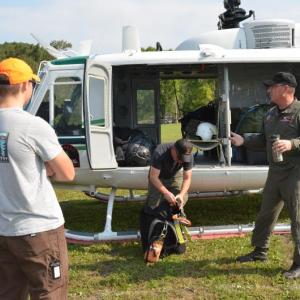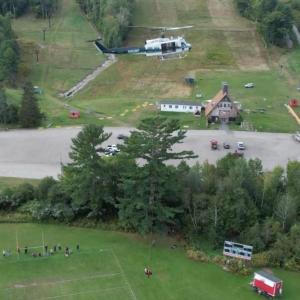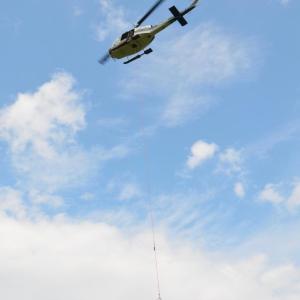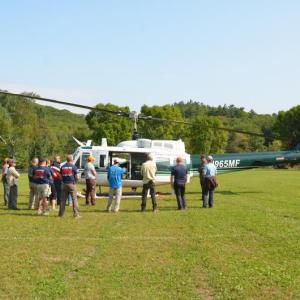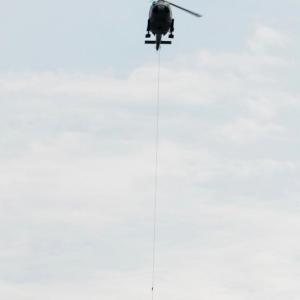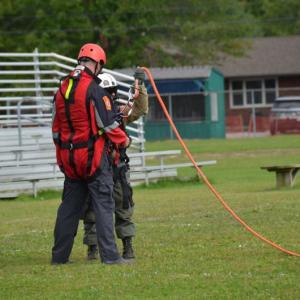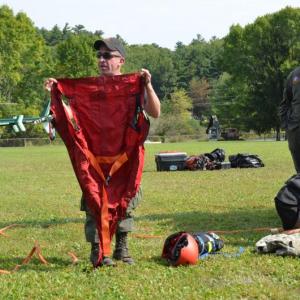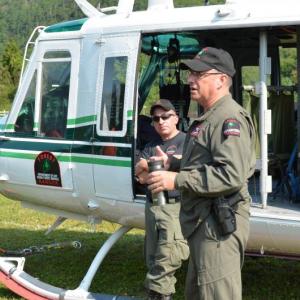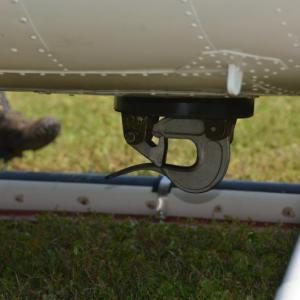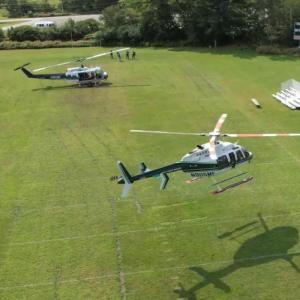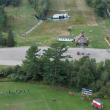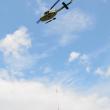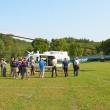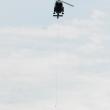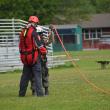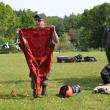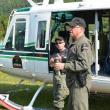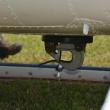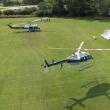Camden Fire Dept., Maine Forest Ranger pilots practice short-haul rescues
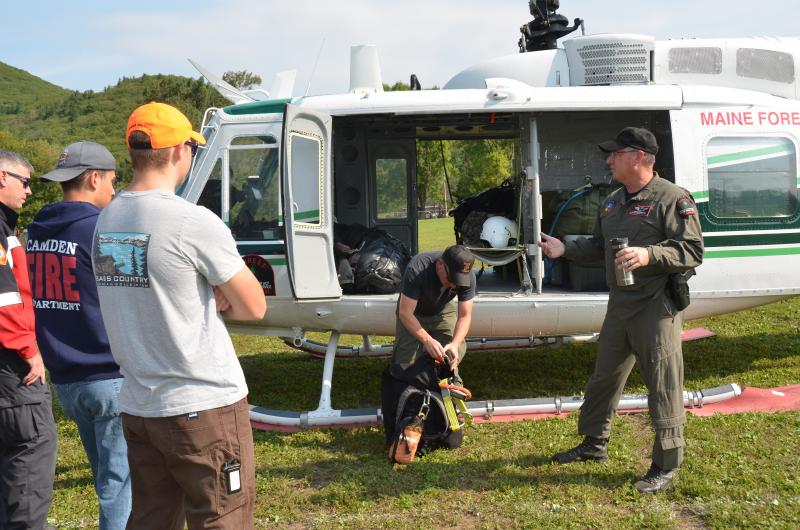 Chief Forest Ranger Pilot John Crowley and District Forest Ranger Scott Maddox spent a few hours Sunday, Sept. 18, with the Camden Fire Dept. and members of the Coastal Maine Search and Rescue explaining how they will assist local fire departments with lifting the injured or sick from remote locations and transfer them to safe landing zones, and waiting ambulances. (Photo by Lynda Clancy)
Chief Forest Ranger Pilot John Crowley and District Forest Ranger Scott Maddox spent a few hours Sunday, Sept. 18, with the Camden Fire Dept. and members of the Coastal Maine Search and Rescue explaining how they will assist local fire departments with lifting the injured or sick from remote locations and transfer them to safe landing zones, and waiting ambulances. (Photo by Lynda Clancy)
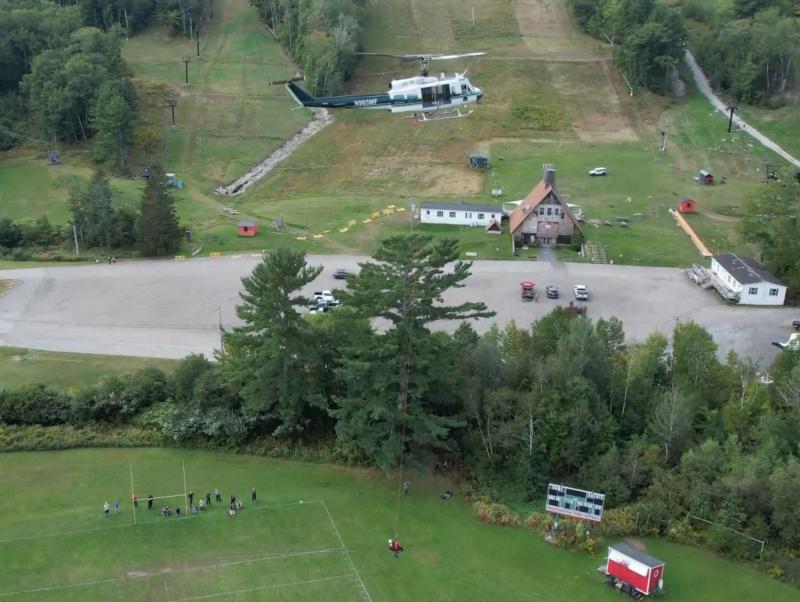 The Maine Forest Service Huey lifts Camden Assistant Fire Chief Andrew Lowe and Maine Forest District Ranger Scott Maddox into flight in a practice extraction for search and rescue methods. (Photo courtesy Todd Anderson)
The Maine Forest Service Huey lifts Camden Assistant Fire Chief Andrew Lowe and Maine Forest District Ranger Scott Maddox into flight in a practice extraction for search and rescue methods. (Photo courtesy Todd Anderson)
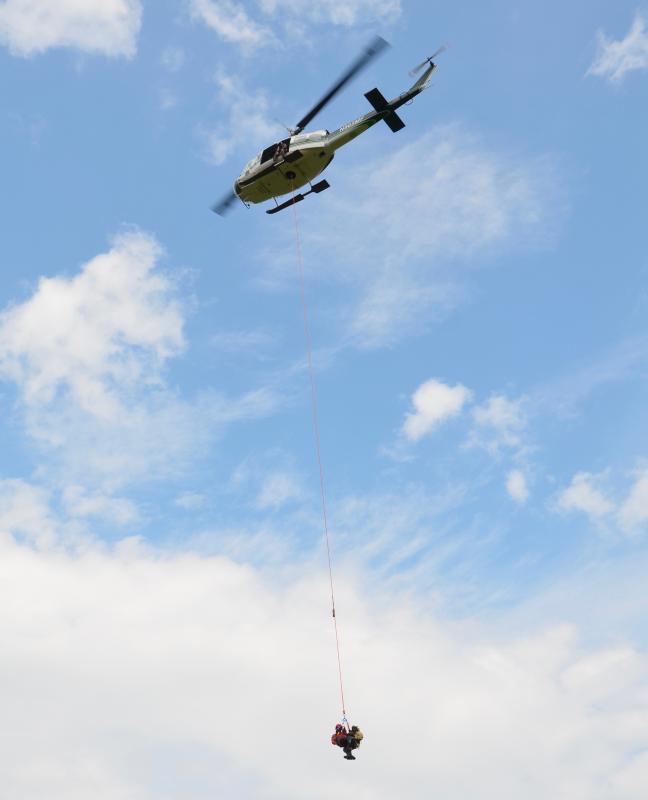 Assistant Fire Chief Andrew Lowe and District Forest Ranger Scott Maddox are exhibiting how a patient and a rescue crew lift and carry across the landscape during a short-haul rescue. (Photo by Lynda Clancy)
Assistant Fire Chief Andrew Lowe and District Forest Ranger Scott Maddox are exhibiting how a patient and a rescue crew lift and carry across the landscape during a short-haul rescue. (Photo by Lynda Clancy)
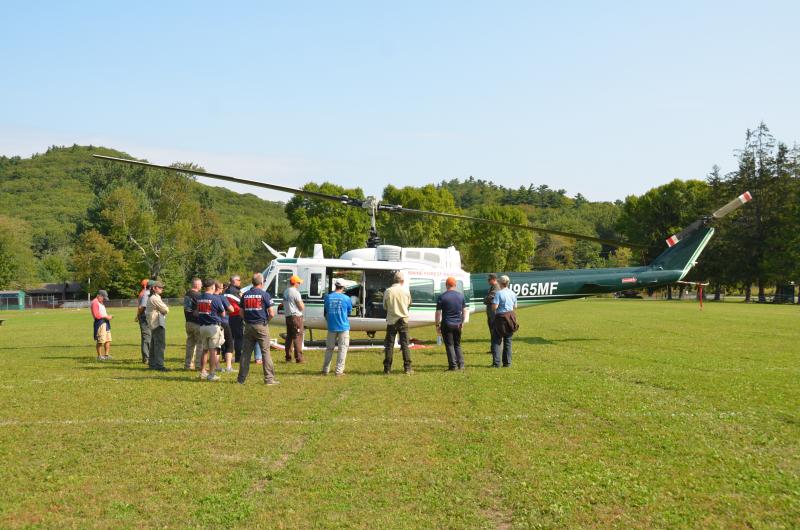 Members of the Camden Fire Dept. gather around one of the five Vietnam era UH-1H (Huey) utility helicopters owned by the Maine Forest Service and which are used for fire fighting and search and rescue. (Photo by Lynda Clancy)
Members of the Camden Fire Dept. gather around one of the five Vietnam era UH-1H (Huey) utility helicopters owned by the Maine Forest Service and which are used for fire fighting and search and rescue. (Photo by Lynda Clancy)
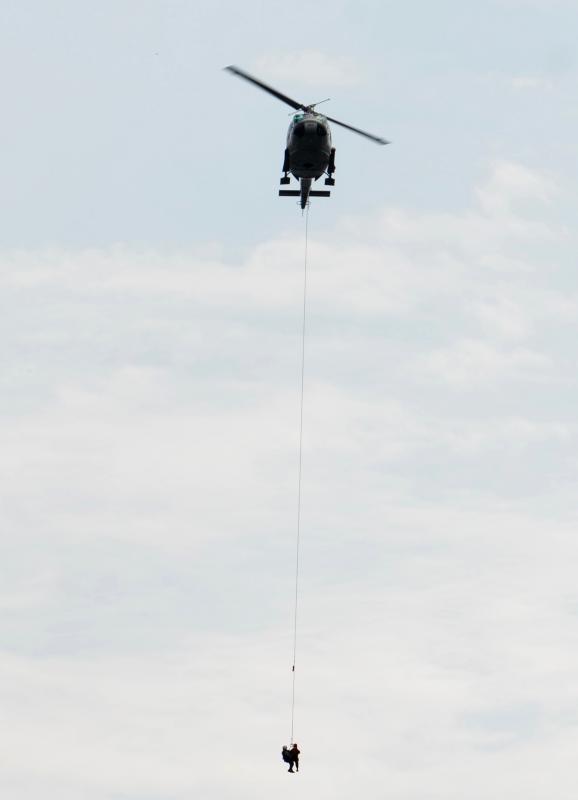
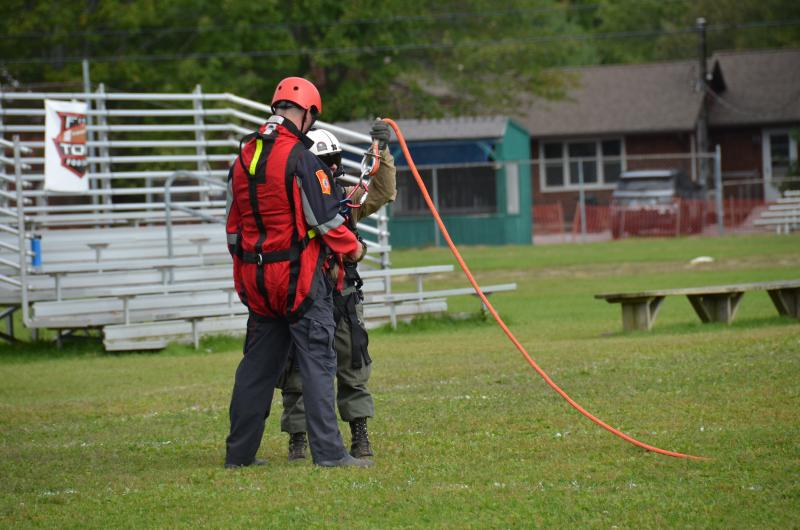 Assistant Fire Chief Andrew Lowe, buckled into a scream suit, waiting with District Forest Ranger Scott Maddox to be lifted by the orange line into the air. (Photo by Lynda Clancy)
Assistant Fire Chief Andrew Lowe, buckled into a scream suit, waiting with District Forest Ranger Scott Maddox to be lifted by the orange line into the air. (Photo by Lynda Clancy)
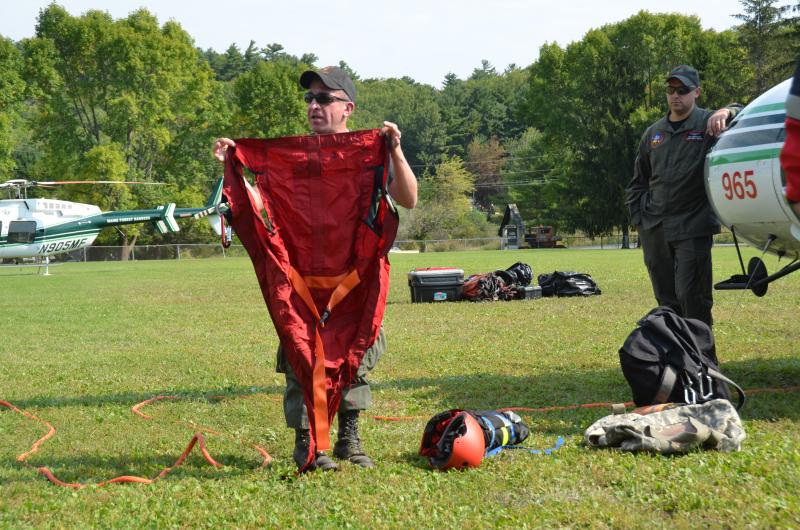 The screamer suit is a a full-body harness that provides a closed safety cover for the patient during a short haul rescue. (Photo by Lynda Clancy)
The screamer suit is a a full-body harness that provides a closed safety cover for the patient during a short haul rescue. (Photo by Lynda Clancy)
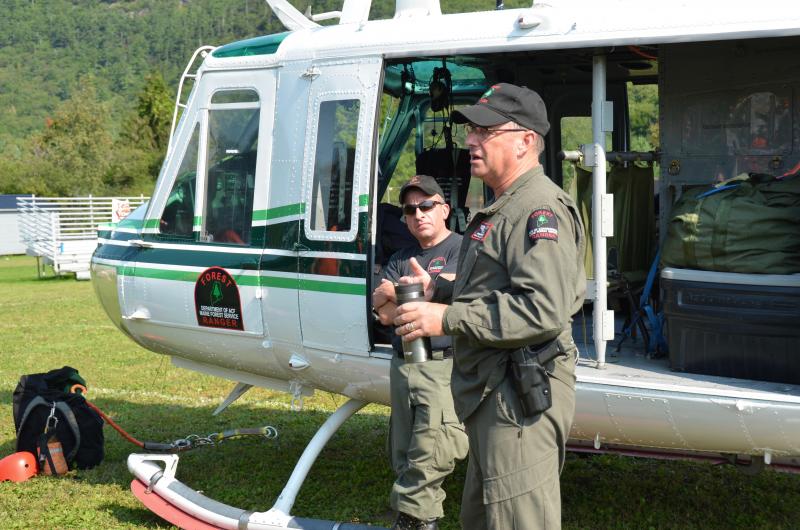
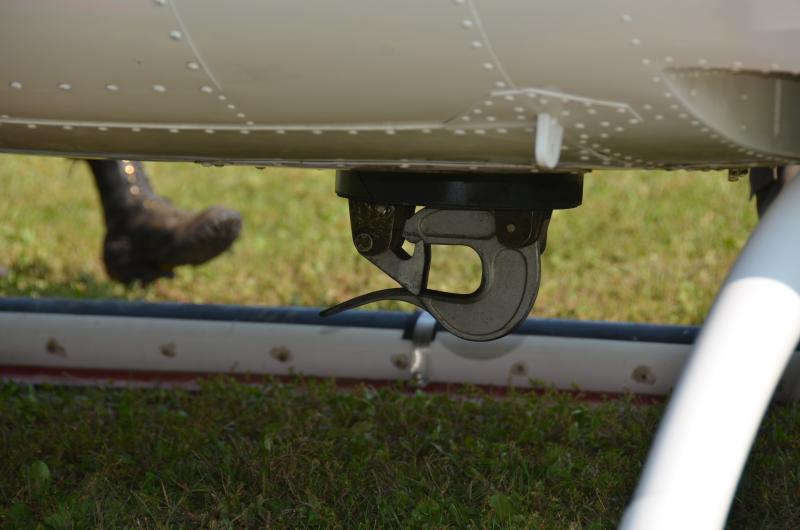
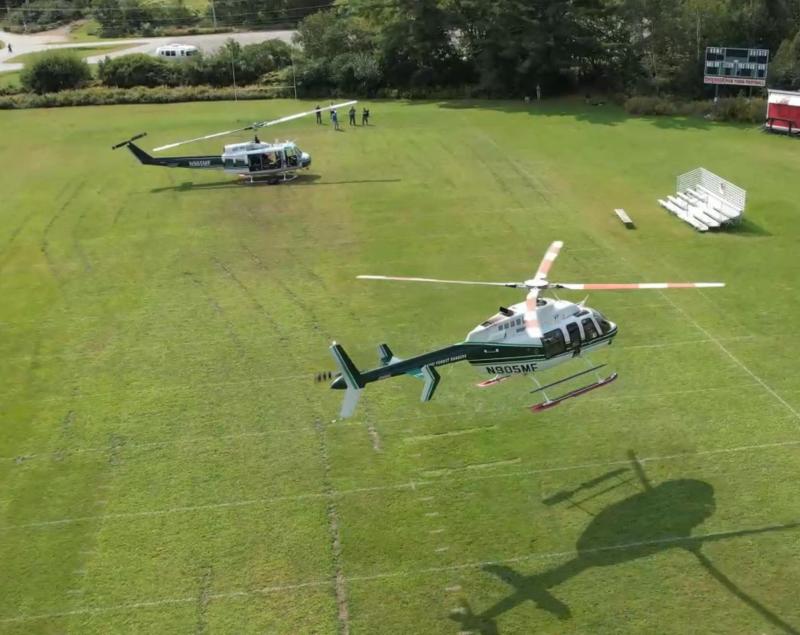 The Maine Forest Service aircraft fleet includes Five Vietnam era (1965-1968) UH-1H (Huey) utility helicopters can only be used for firefighting, law enforcement, and search and rescue. They carry up to 10 firefighters and a 240-gallon bucket of water. Three of the five have been overhauled at the factory, but all show signs of age and wear.
Two smaller civilian helicopters (Bell 407 and 206) carry three to six passengers and less water. They can be used for any mission that the rangers perform – fire, law enforcement, search-and- rescue, OIT communication towers, DIFW moose surveys, etc.
Three aging fixed-wing aircraft- Cessna L-19, C-180, C-185 (1952-1980) on wheels, skis, and floats used for fire patrol, surveys, and transportation.
(Photo courtesy Todd Anderson)
The Maine Forest Service aircraft fleet includes Five Vietnam era (1965-1968) UH-1H (Huey) utility helicopters can only be used for firefighting, law enforcement, and search and rescue. They carry up to 10 firefighters and a 240-gallon bucket of water. Three of the five have been overhauled at the factory, but all show signs of age and wear.
Two smaller civilian helicopters (Bell 407 and 206) carry three to six passengers and less water. They can be used for any mission that the rangers perform – fire, law enforcement, search-and- rescue, OIT communication towers, DIFW moose surveys, etc.
Three aging fixed-wing aircraft- Cessna L-19, C-180, C-185 (1952-1980) on wheels, skis, and floats used for fire patrol, surveys, and transportation.
(Photo courtesy Todd Anderson)
 Chief Forest Ranger Pilot John Crowley and District Forest Ranger Scott Maddox spent a few hours Sunday, Sept. 18, with the Camden Fire Dept. and members of the Coastal Maine Search and Rescue explaining how they will assist local fire departments with lifting the injured or sick from remote locations and transfer them to safe landing zones, and waiting ambulances. (Photo by Lynda Clancy)
Chief Forest Ranger Pilot John Crowley and District Forest Ranger Scott Maddox spent a few hours Sunday, Sept. 18, with the Camden Fire Dept. and members of the Coastal Maine Search and Rescue explaining how they will assist local fire departments with lifting the injured or sick from remote locations and transfer them to safe landing zones, and waiting ambulances. (Photo by Lynda Clancy)
 The Maine Forest Service Huey lifts Camden Assistant Fire Chief Andrew Lowe and Maine Forest District Ranger Scott Maddox into flight in a practice extraction for search and rescue methods. (Photo courtesy Todd Anderson)
The Maine Forest Service Huey lifts Camden Assistant Fire Chief Andrew Lowe and Maine Forest District Ranger Scott Maddox into flight in a practice extraction for search and rescue methods. (Photo courtesy Todd Anderson)
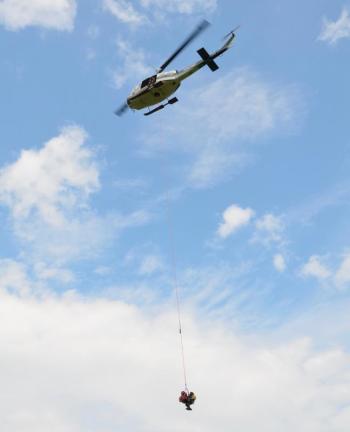 Assistant Fire Chief Andrew Lowe and District Forest Ranger Scott Maddox are exhibiting how a patient and a rescue crew lift and carry across the landscape during a short-haul rescue. (Photo by Lynda Clancy)
Assistant Fire Chief Andrew Lowe and District Forest Ranger Scott Maddox are exhibiting how a patient and a rescue crew lift and carry across the landscape during a short-haul rescue. (Photo by Lynda Clancy)
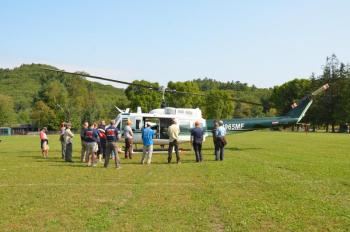 Members of the Camden Fire Dept. gather around one of the five Vietnam era UH-1H (Huey) utility helicopters owned by the Maine Forest Service and which are used for fire fighting and search and rescue. (Photo by Lynda Clancy)
Members of the Camden Fire Dept. gather around one of the five Vietnam era UH-1H (Huey) utility helicopters owned by the Maine Forest Service and which are used for fire fighting and search and rescue. (Photo by Lynda Clancy)
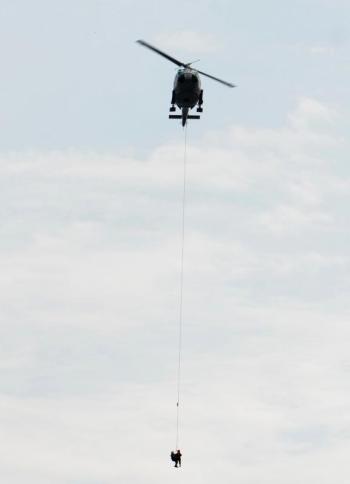
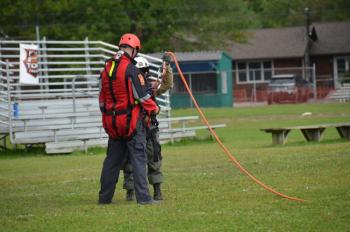 Assistant Fire Chief Andrew Lowe, buckled into a scream suit, waiting with District Forest Ranger Scott Maddox to be lifted by the orange line into the air. (Photo by Lynda Clancy)
Assistant Fire Chief Andrew Lowe, buckled into a scream suit, waiting with District Forest Ranger Scott Maddox to be lifted by the orange line into the air. (Photo by Lynda Clancy)
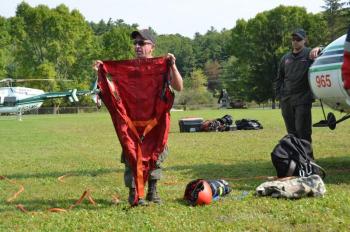 The screamer suit is a a full-body harness that provides a closed safety cover for the patient during a short haul rescue. (Photo by Lynda Clancy)
The screamer suit is a a full-body harness that provides a closed safety cover for the patient during a short haul rescue. (Photo by Lynda Clancy)
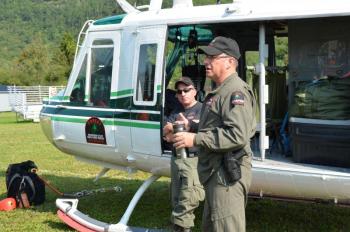
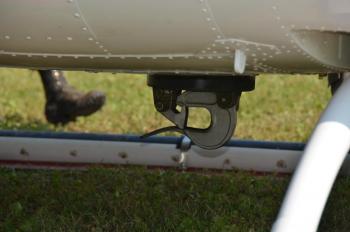
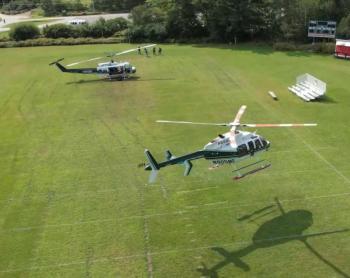 The Maine Forest Service aircraft fleet includes Five Vietnam era (1965-1968) UH-1H (Huey) utility helicopters can only be used for firefighting, law enforcement, and search and rescue. They carry up to 10 firefighters and a 240-gallon bucket of water. Three of the five have been overhauled at the factory, but all show signs of age and wear.
Two smaller civilian helicopters (Bell 407 and 206) carry three to six passengers and less water. They can be used for any mission that the rangers perform – fire, law enforcement, search-and- rescue, OIT communication towers, DIFW moose surveys, etc.
Three aging fixed-wing aircraft- Cessna L-19, C-180, C-185 (1952-1980) on wheels, skis, and floats used for fire patrol, surveys, and transportation.
(Photo courtesy Todd Anderson)
The Maine Forest Service aircraft fleet includes Five Vietnam era (1965-1968) UH-1H (Huey) utility helicopters can only be used for firefighting, law enforcement, and search and rescue. They carry up to 10 firefighters and a 240-gallon bucket of water. Three of the five have been overhauled at the factory, but all show signs of age and wear.
Two smaller civilian helicopters (Bell 407 and 206) carry three to six passengers and less water. They can be used for any mission that the rangers perform – fire, law enforcement, search-and- rescue, OIT communication towers, DIFW moose surveys, etc.
Three aging fixed-wing aircraft- Cessna L-19, C-180, C-185 (1952-1980) on wheels, skis, and floats used for fire patrol, surveys, and transportation.
(Photo courtesy Todd Anderson)
CAMDEN — Distress calls from hikers in the hills around Camden, Rockport and Lincolnville have increased in volume and frequency as more visitors take to the mountain trails of the state park. It is not uncommon now for local firefighters and volunteers trained in search and rescue to grab their hiking boots, a backpack and water, headlamps, and a litter with handles to carry the injured or ill down from the summit of Megunticook, Bald Rock and Mt. Battie.
The hike back out to the road and waiting ambulances can be long – sometimes hours – and arduous, especially if the injured is large and heavy.
Sometimes, it is a dead body that is being carried out of the woods, or it can be a medical emergency that demands immediate response.
So to know that the Maine Forest Service, with its aviation branch, might be available for short-haul rescues is a comfort, and a viable resource.
“It’s called short-haul because you are hauling the patient the shortest distance possible to the next level of care,” said Maine Forest Service Chief Pilot John Crowley, speaking to the Camden Fire Dept., Sept. 18, during a training session at the Camden Snow Bowl.
The pilots and rangers that fly rescue missions train weekly with medics especially for those situations, for they know the calls to Knife’s Edge on Katahdin or the cliffs of Acadia National Park can come at any time.
They maintain their equipment, checking and rechecking the harnesses, the carabiners, the hooks and the 100-foot lengths of orange rope used to lift two or sometimes three people from a dangerous spot and fly them to safety.
They train to fly into precarious situations, and plan for any eventuality.
On Sunday morning, Chief Crowley and Ranger Pilot Joel Tourtelotte, along with District Ranger Scott Maddox, convened with the Camden Fire Dept. for two hours, explaining the process of helicopter short haul rescues, and even trying one with Assistant Fire Chief Andrew Lowe as the victim.
They arrived in two helicopters, a 1965 Vietnam aircraft, the UH-1H (Huey), and a smaller and newer civilian Bell 206 helicopter, landing on the Snow Bowl playing field. The winds were light that day, and skies were clear.
Since 2012, Maine’s Forest Protection air fleet and crew has been conducting aerial rescue missions. Over the past decade, they — the chief pilot and four ranger pilots, who are dual-rated in fixed-wing and helicopter – have helped with more than 22 search and rescue operations with state police, game wardens, and fire departments.
Most of the pilots have military training, and have gone through Navy flight school. A mechanic supervisor and three FAA-certified aircraft mechanics maintain the fleet, which comprises five Hueys and two Bells.
“The equipment we are using now is so much better than what I used in the Marine Corps,” Crowley said, pointing toward the large hook attached to the bottom of the Huey. That hook fastens the lifeline, the orange rescue rope that secures the patient to the aircraft while in flight.
“You'll see when Scotty [Maddox] hooks it up, there’s a secondary belly band,” said Crowley. “When we are lifting an ATV or a net full of equipment, it just goes on the hook. It’s right under the center of balance of the aircraft, so it flies exactly the same, whether you have weight on it or not. If you have 2,000 pounds of water hanging underneath, you notice but it doesn't affect the flight characteristic.”
He added: “However, if you have a live body, we have a secondary belly band, and that wraps around the center of the aircraft.”
The aviation fleet dispatches solely through the Bangor Emergency Dispatch Center.
“It doesn’t matter if you are calling from Houlton or Camden or Rangeley, the number goes to Bangor dispatch,” said Crowley. “The calls all come to me, and if some reason I am not available – it hasn’t happened in 13 years — the call will go to whoever the duty officer is. We’ll start discussing the rescue.”
He turned to Camden Fire Chief Chris Farley.
“So, Chief, if you call and say you’ve got an injured climber and they are on a side of a cliff — cliffs are kind of hard for us because we’re not rock climbers – we’ll talk about how the rescue will go. But we’ve done it. We’ve gotten into some pretty small, hairy places to get people out.”
When night is on the approach, and rescuers have but six people to carry the injured person out, the situation on the ground can get dicey.
“A two-mile carry with some of the trails you have in the park here, you’re going to have a hard time doing that,” he said. “In Baxter, we always say, it takes 40 people per mile to carry somebody off that mountain. So, a two to three-mile carry, it is going to take 80 people. It’s very difficult to do that, and very risky for the people who are carrying. A lot of times you are in the rocky section and handing the litter, hand over hand, like a bucket brigade.”
He said the Forest Service ranger pilots will help in those situations, first to package the patient, and then fly them out.
They often take a paramedic with them on the rescue flight. The ranger pilots have an agreement with Old Town Fire Dept., which has eight or nine paramedics that train with the pilots several times a year.
“We extricate and Old Town Fire does any medication that needs to be done,” said Crowley.
If the ranger pilots are heading to the Appalachian Trail, or the western part of the state, they will pick up medics with North Star in Farmington, another emergency medical service.
“What I always say about Baxter is that it takes the same amount of time to climb Katahdin in June as it does in September,” he said. “But in June we get two hours more daylight to get them. Nobody gets hurt in the morning. It’s always in the afternoon. They are tired. They are on their way back down. I have asked the wardens and park rangers at Baxter and Acadia, to ‘just call us.’ If you think you’ve got something where you need us and it is 1 p.m., but you’re not sure, just call. I’ll start pulling people out of the woods and get them in the right spot. Maybe we don’t go. That’s not a problem for us. Maybe we are on our way there and they say, ‘we’ve got her and are safe.’ It’s just jet fuel. We will turn around and go back.”
But if he is trying to scramble at the end of the day when light is fading, the work gets more problematic. In that situation, Crowley will ask the National Guard for an assist.
“If it’s 30 minutes before sunset, we can’t do it,” he said. “We don’t have a night vision goggle program. I can put you in touch with the Guard. There’s no better platform to do a hoist with goggles than on a Black Hawk. It’s a great ship. The crews are all trained.”
During the Sunday training, District Ranger Maddox uncoiled the orange line, which is kept in 100-foot sections. He demonstrated how the helicopter is prepped for transporting a patient, and noted how methodically they approach each emergency response.
“When we feel rushed, we all slow down,” said Maddox. “If we need a minute to think about it, we’ll shut down to rig the helicopter. We prefer to take our time. That’s so there are no mistakes. That’s why John says, if you are thinking of calling us, call early so we can get everything in motion.”
He recounted a time on Knife’s Edge, on Katahdin, when there was a verbal communication issue.
“I couldn’t talk, and they [the pilot] couldn’t hear me,” he said. “So we switched to hand signals. We also train in hand signals in case that happens.”
As he descends to help a patient stuck on a mountain cliff, Maddox sometimes has a paramedic right alongside him.
“So it’s me on one side, the paramedic on the other, and we fly with the patient in the middle of us, so we have access from head to toe on the patient, in case we need it,” he said.
He unpacked the screamer suit, a large red full-body harness into which the injured is placed. It is designed to encompass the torso to prevent a person from inadvertently falling out and is safe to use with the disabled or unconscious. Maddox also displayed the Bauman Bag, which can be used for transporting patients on a backboard.
The Bauman Bag also can accommodate a litter, or Stokes basket.
“We haven’t found a fire department litter that does not fit in our Bauman Bag,” said Maddox. “So once you have them in the litter, you don’t need to take them out.”
When lifted in a screamer suit, “All we tell the patient to do is sit back, like you’re in a chair,” he said. “We put the helmet on them, and we have a pair of safety glasses we put on them, as well.”
Crowley told the firefighters that their role, when the ranger pilots are lowering a patient back to the ground, is to help stabilize the patient and stop any swing of the patient.
The pilots also stressed that wearing orange or lime green is prerogative.
“Being up above you’d think we can see down really well, but we can’t always,” said Maddox. “So if you have fluorescent orange in your search and rescue gear, put that on. It makes it so much easier for us to spot you. Instead of saying, ‘I’m over here by the big tree.’ That’s not helpful, because everything is big.”
Crowley added that strobe flashlights are also helpful in locating the scene.
“Just aim it right at us,” he said.
Chief Farley said he envisioned calling upon the ranger pilots for higher mountain rescues.
“For us, the biggest challenge is when somebody is up on the summit of Megunticook or Ocean Lookout, because it is a steep climb coming down,” he said. “No matter which way you go, it is a steep descent.”
He said the concern is always the number of volunteers available to help to bring the injured down.
Likewise, there have been two occasions when hikers succumbed to heart attacks near the top of Megunticook.
“In that situation, there is no urgency,” he said, and to have the helicopter transport a body down takes the load off of firefighters having to walk the body down the mountain.
During the demonstration, Maddox packed Camden Assistant Fire Chief Andrew Lowe into a screamer suit, and remained by his side while the Huey lifted off the ground. The orange line stretched with tension, as the two were hoisted into the air. The helicopter flew into the sky, 300 feet or higher, skirting the side of Ragged Mountain, over Hosmer Pond, and then returned back to the ball field.
“It gets pretty cozy, and when you have three people, you’ve got to interlock legs,” said Crowley. “We’ve done it with four. I can’t tell whose arm is what arm. But you’ve just got to make it all work. We always say we try to put somebody on top of a picnic table. If we’ve got a 10-foot circle, we will put them in it.”
Sometimes, they have to use chain saws in the woods to create that space. But they are rangers, and they all know how to use chain saws.
“It was almost like sitting in a lounge chair,” said Lowe, after he returned to the ground. “Unless you look up, you can’t really see the helicopter. You can hear it, but it is surprisingly not that loud.”
Reach Editorial Director Lynda Clancy at lyndaclancy@penbaypilot.com; 207-706-6657

